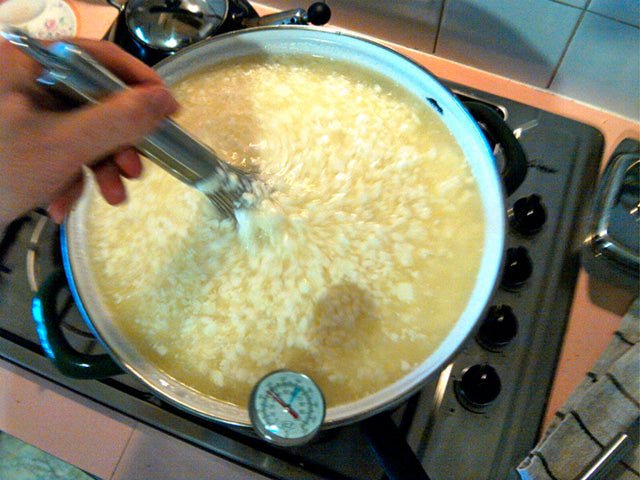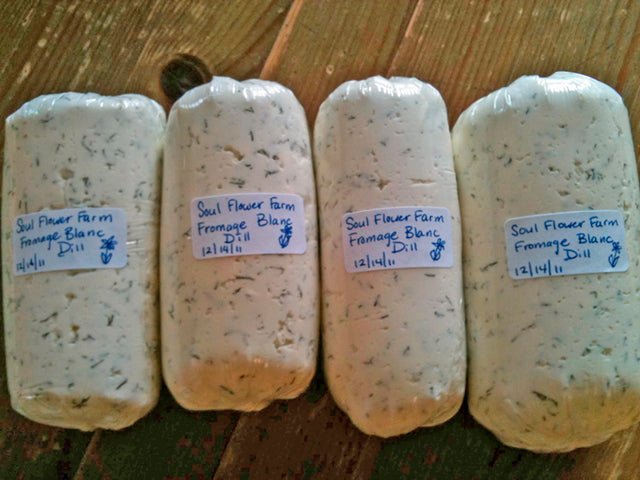Maybe I favor Gavin’s work a little too much – I’ve already featured his Wensleydale and Caerphilly in previous articles.
But, the truth is I can’t say enough about the contribution he is making to home cheese making. It’s all based on his extensive experience, and it’s all free!
Gavin lives in Australia, so he presents his measurements in the metric system. That can be discouraging, but it’s really very easy to convert his numbers to our Imperial system by using an online converter. It’s well worth the few minutes it takes.
For this article, I asked Gavin to give us an update from the “Land Down Under:”
In July 2011, I had so many cheese recipes, cheese making tips and video tutorials on my main blog “The Greening of Gavin,” that I decided to spawn a new cheese blog that captures all of my cheese making efforts. It is called Little Green Cheese, and features over 17 different types of cheese so far. Kind of a one stop shop of cheese making ‘how to’ so to speak.
My cheese making goal this year is to attempt to post a new video tutorial every month now that our hot summer is starting to calm down here in Australia. The weather is turning cooler and now just right for cheese making. On my to do list is a drunken goat cheese, Haloumi, Colby, and another attempt at repeating a serendipitous discovery that I called Farmhouse Pepper Blue!
However, my all time favorite cheese is Parmesan, or properly known as Parmigiano Reggiano. I try and make about 1kg (2.2lbs) every few months to keep up with supply at home. It takes a long time to mature (I leave it for 12 months minimum), but it tastes divine!
Parmesan
By Gavin Webber at Little Green Cheese
This well known Italian cheese is one of my favorites and I have made it about 8 times, with each wheel being a success. In fact, I try and make one about every 3 months to keep up with the constant supply necessary for our appetite for this strong, flavorsome cheese.
Parmesan is really called Parmigiano Reggiano, named after the two regions in Italy where it is made. It is one of the worlds most famous grating cheeses. Normal sized wheels of Parmigiano Reggiano weigh about 46 kg each (101 lb), but this recipe is modified to make about 1 kg (2.2 lb) of this delicious cheese. It certainly beats the crappy, smelly, powered cheese you can buy in those green containers! Everyone in my family gives it a massive two thumbs up, and we eat it shaved or grated on many types of pasta dishes.
I have made a video tutorial for this cheese in two parts, so to get a feel for how I made it, sit back, relax and enjoy the show. (Note: I have converted all Gavin’s measurements from the metric system to ours in the copy below, so you should be able to follow along with him in these videos.)
Part 1
Part 2
Method:
Ingredients:
Brine solution (1 litre (1 qt) water plus 2 tablespoons non-iodized salt, boiled for 5 minutes)
4 litres (1 gallon) full cream milk, at least 3.4% fat
4 litres (1 gallon) lite or semi skimmed milk, no more than 1.4% fat.
1 quarter teaspoon direct set thermophilic starter culture
1 quarter teaspoon lipase powder, mixed with 20 ml (4 tsp) of unclorinated water
2.5 ml (1/2 tsp) rennet mixed with 60 ml (1/4 cup) unclorinated water
2.5 ml (1/2 tsp) calcium chloride mixed with 60 ml (1/4 cup) unclorinated water
As usual I set up all the utensils and ingredients before I begin, then I sterilize everything in water in the 8 litre pot (2 gallon) for 15 minutes. People are often surprised to discover that it is made with low fat milk (no more than 2.5% fat), because it has such an intense flavor.
Once sterilized, I put the big pot on a small saucepan of water to act as a double boiler.
Add the milk and alternate a litre of each type to so that it mixes well, and then bring the temperature up to 35C (95F). Once at temperature, add the thermophilic culture and mix well. Cover and allow to sit for 15 minutes.
Add the calcium chloride and mix well. Then add the lipase mixture and stir for a minute. Keeping the mixture at 35C (95F), add the rennet mix and stir for at least 1 minute. Remove from heat. Cover and allow to set for 45 minutes.
When you get a clean break, cut the curd by using a balloon whisk. Push the whisk all the way to the bottom of the pot and lift back out. Do this all the way around all over the surface for 3 times. This will ensure that you have cut the majority of the curd to about 4 mm (1/8 in). Let stand for 5 minutes, then stir at 35C (95F) for 10 minutes.
Increase the temperature to 42C (108F) over half an hour and hold this temperature for 15 minutes continuously stirring with the whisk to prevent matting. You will notice that the curd will start to shrink into smaller grain sized pieces.
Increase the temperature to 52C (126F) over half an hour stirring regularly. When the temperature has been reached you should notice that the curd will have a very small grain size and that it will be dry to touch and squeaky when you chew them to test for doneness. Let the curds rest for 5 minutes off the heat.
Drain the curds and whey into a cheese cloth lined colander. Be careful as the whey is quite hot. Gather up the cheese cloth and form a ball of curd big enough to fit into your 900 gm (2lb) mold. Cover one of the corners of the curd with the cheese cloth and top with the follower then press at 2.5kg (5 1/2 lb) for 15 minutes.
Remove the cheese from the press, and slowly unwrap the cloth. Turn the cheese over, rewrap it in the cloth, and press at 5kg (11 lb) for 30 minutes. Repeat this procedure, press at 7.5 kg (16 1/2 lb) for 2 hours. Repeat again, pressing at 10kg (22 lb) for 12 hours.
Remove the cheese from the mold and unwrap. Immerse the cheese in the brine solution. I use a 2 litre (1/2 gallon) ice cream container, add the cheese first then pour over the brine. The brine should be at room temperature and not hot or the cheese will begin to break up and absorb too much salt.
Leave it at room temperature (21C) (70F) for 24 hours, and flip the cheese occasionally.
Take the cheese out of the brine solution and pat it dry with paper towel. Here is your chance to smooth the cheese with your hands if there are any rough bits. Then place on a sushi mat and put it into the cheese cave at 13C (55F)/80% humidity for 10 months. Turn the cheese daily for the first week, then weekly after that. Remove any mould that forms on the exterior with some left over brine and a bit of cheese cloth. This also helps to harden the cheese as it ages.
I usually wax this cheese at about the three month mark, because otherwise, even if rubbed with olive oil the wheel is just too small to hold the required amount of moisture and it will dry out. The first wheel of Parmesan made in May 2009 turned out very well and had that sharp flavor that Grana cheeses are well known for.
The trademark texture and flavor of this cheese is obtained though the lengthy maturation process which results in a cheese with a hard, gritty texture. I guarantee that this cheese is well worth the wait.



















































































































































